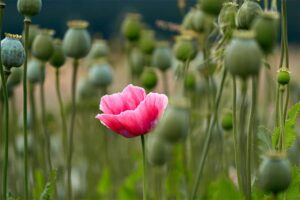 In the realm of dreams, goals and visions, the idea of scattering annual poppy seeds on snow is probably not very high on anyone’s list. But I have never managed to do it, so it has remained a gardening goal for years now. Some years I have had seeds but no snow. Some years I have had snow but no seeds. Occasionally I have had seeds and snow, but have forgotten the planting goal in favor of other things, like shoveling the snow or calling the plumber because the heat has gone off.
In the realm of dreams, goals and visions, the idea of scattering annual poppy seeds on snow is probably not very high on anyone’s list. But I have never managed to do it, so it has remained a gardening goal for years now. Some years I have had seeds but no snow. Some years I have had snow but no seeds. Occasionally I have had seeds and snow, but have forgotten the planting goal in favor of other things, like shoveling the snow or calling the plumber because the heat has gone off.
This year, however, seeds, snow, inclination and timing came together. Yesterday I took five minutes and spread a package of tiny poppy seeds on the snow that covered the beds bordering my front walk. Now all I have to do is wait to see whether the old gardening wisdom about the efficacy of this particular planting method is right.
My poppy seeds are the bread seed type, Papaver somniferum, also known as the opium poppy. If you are into Latin root words, you will recognize that “somnus” means sleep or sleep-inducing, as in the English word “somnolent”, or the name of the patent insomnia medicine Sominex. Some vendors do not like the associations of the “opium poppy’ designation, and prefer the “bread seed poppy” name.
The varietal name is ‘Imperial Pink’, and, with luck, the seeds will produce two to three- foot flower stalks, adorned with the dissected, almost ferny foliage characteristic of poppies. The flowers have the crepe paper-like petals characteristic of all poppies—at once delicate and strong. Each flower is pale pink at the outer petal edges, shading to darker pink towards the center, with central markings of pale lavender. The petal edges may be fringed or not, depending on the inclination of the plant. With all poppies, the added bonus is the rounded seedheads, which are eye-catching all by themselves, and can be dried to use in everlasting arrangements. I have seen striking holiday wreathes adorned with gold-painted poppy seedheads. That might be a possibility for me next December if my seeds-on-snow planting method works.
At one time, the seeds-on-snow advocates thought that annual poppy seeds needed a period of chilling, sometimes called “cold stratification” to germinate. This does not seem to be true, but poppies do need light to germinate and prefer a cool spring period. Dropping the seeds on snow or frozen ground imitates what might happen if existing poppy plants self-seeded. Summer flowers would eventually give way to seedheads, which would ultimately dry and split open in the fall. Winter would take its course and the tiny seeds would germinate in early spring as the ground begins to warm.
Opium poppies are not the only ornamental species that take to snow sowing. Corn poppies, sometimes called “Shirley poppies”, or Papaver rhoeas, descended from the wild European corn poppy of “Flanders Field” fame, may also respond to the same treatment. For pops of red in the beds and containers, there is nothing like them, but red is far from the only available color. The vaguely naughty-sounding Iceland poppies, Papaver nudicaule, bloom in an array of warm pastel colors from seeds that can be “planted” in winter. Fluffy-headed peony-flowered poppies, Papaver paeoniflorum, with their sumptuous blooms and characteristic seedheads, may also be snow-sown.
Tall, flashy oriental poppies—Papaver orientalis—are perennials usually sold as starter plants, but some vendors also offer them as seeds, which is a cost-saving way of acquiring multiple specimens. If you choose that route, try the snow sowing method. It may work so well that you will have blooms the first year, though as with all things horticultural, there are no iron-clad guarantees. I am especially fond of ‘Royal Wedding’, with pure white petals and dramatic black central blotches.
Of course, since life is full of variables, I generally tend to hedge my bets-even flowery ones. For insurance purposes, I ordered a second package of ‘Imperial Pink’ poppies to plant around the time of the first frost date for my area. If snow sowing doesn’t work, I will still have poppies. If it does work, I will have perfected succession planting and enjoy more poppies for a longer period of time. It’s a floral “win-win” strategy.
Nurseries and garden centers stock flower seeds at this time of year, and you may be able to find poppy seeds among their offerings. For a good selection of many annual and perennial poppy types, go to Select Seeds, 180 Stickney Hill Road, Union, CT 06076; (800) 684-0395; www.selectseeds.com. Print catalog available.
